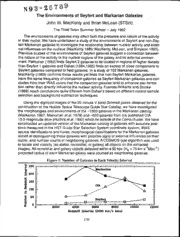
NASA Technical Reports Server (NTRS) 19930017600: The environments of Seyfert and Markarian galaxies PDF
Preview NASA Technical Reports Server (NTRS) 19930017600: The environments of Seyfert and Markarian galaxies
The Environments of Seyfert and Markarian Galaxies John W. MacKenty and Brian McLean (STScI) The Third Teton Summer School -- July 1992 The environments of galaxies may affect both the presence and nature of the activity in their nuclei. We have undertaken a study of the environments of Seyfert and non-Sey- fert Markarian galaxies to investigate the relationship between nuclear activity and exter- nal influences on the nucleus (MacKenty 1989; MacKenty, McLean, and Simpson 1990). Previous studies of the environments of Seyfert galaxies suggest a connection between the nature of the activity in the nuclear regions of the galaxy and its external environ- ment. Petrosian (1982) finds Seyfert 2 galaxies to be located in regions of higher density than Seyfert 1 galaxies and Dahari (1984,1985) finds an excess of close companions to Seyfert galaxies compared to field galaxies. In a study of 102 Markarian galaxies, MacKenty (1989) confirms these results yet finds that non-Seyfert Markarian galaxies have the same frequency of companion galaxies as Seyfert Markarian galaxies and con- cludes from their IRAS colors that the companion galaxies tend to enhance star forma- tion rather than directly influence the nuclear activity. Fuentes-Williams and Stocke (1988) reach conclusions quite different from Dahari's based on different control sample selection and background subtraction techniques. Using the digitized images of the 20 minute V band Schmidt plates obtained for the construction of the Hubble Space Telescope Guide Star Catalog, we have investigated the morphologies and environments of the -1500 galaxies in the Markarian catalog (Markarian 1967; Markarian etal. 1979) and -600 galaxies from the published CfA 15.5 magnitude slice (Huchra et al. 1990) which lie outside of the Coma cluster. We have constructed an updated version of the Markarian catalog of galaxies with accurate posi- tions measured in the HST Guide Star Selection System coordinate system, IRAS source identifications and fluxes, morphological classifications for the Markarian galaxies aimed at distinguishing those galaxies with possible signs of external influences on their nuclei, and number counts of neighboring galaxies. A COSMOS type algorithm was used to locate and classify (as stellar, nonstellar, or galaxy) all objects on the extracted images. All nonstellar and galaxy objects detected within a 50 kpc (H = 75 km s~1Mpc"1) 0 projected radius of each Markarian galaxy were counted as neighboring galaxies. Figure 1: Number of Galaxies in Each Velocity Interval 250 100 50 2000 4000 6000 8000 10000 12000 Redshift Interval (2000 km/s bins) 170 Figure 1 shows the differing redshift distributions of the galaxy populations. The incompleteness of the Markarian survey and the rather different distribution of the Sey- fert galaxies subset are evident. This may have been a significant source of bias in prior studies. To control this bias, the sample was binned into 2000 km s"1 intervals. The frac- tion of the galaxies in each interval with neighbors within 50 kpc projected distance is shown in Figure 2. Figure 2: Frequency of Neighbors within 50 kiloparsecs 0.8 0.2 0 2000 4000 6000 8000 10000 12000 Redshift Interval (2000 km/s bins) Conclusions • We find an enhancement in the relative frequencies of companion galaxies about Markarian (and Seyfert) galaxies compared to the CfA galaxies but at a lower level than the enhancement found by Dahari (1984). This enhancement tends to decrease with the imposition of size constrains on potential companion galaxies supporting the suggestion of Fuentes-Williams and Stoeke (1988) that small companions may be important. • Within the Markarian sample, we find that the relative frequencies of Seyfert, Star- burst, and UV excess nuclear activity are independent of their immediate environments in agreement with the conclusions of MacKenty (1989). This is not to imply that nuclear activity per se is not influenced by environment but rather that the type of nuclear activity (at least for Markarian galaxies) does not appear to be determined by the environment. • Within the Markarian sample, there is no strong correlation between the type of nuclear activity and the morphology of the host galaxy although bar and ring morpholo- gies are somewhat more common in Seyfert and Starburst galaxies. Dahari, O. 1984, A.J. 89,966. Dahari, O. 1985, Ap.J. Suppl., 57, 643. Fuentes-Williams, T. and Stoeke, J.T. 1988, A.J. 96,1235. Huchra, Geller, DeLapparent, and Corwin 1990, Ap.J. Suppl., 72, 433. MacKenty. J.W. 1989, Ap.J., 343, 125. MacKenty, J.W., Mclean, B., and Simpson, C. 1990, in Paired and Interacting Galaxies (eds. Sulentic, J.W., Keel, W.C., and Telesco, C.M.; IAU Colloquium No. 124; NASA Conference Publication 3098), p. 165. Markarian, B.E. 1967, Astrofizika, 3, 55. Markarian, B.E., Lipovetskii, V.A., and Stepanian, D.A. 1979, Astrofizika, 15, 549. Petrosian, A.R. 1982, Astrofizika, 18, 548. 171
